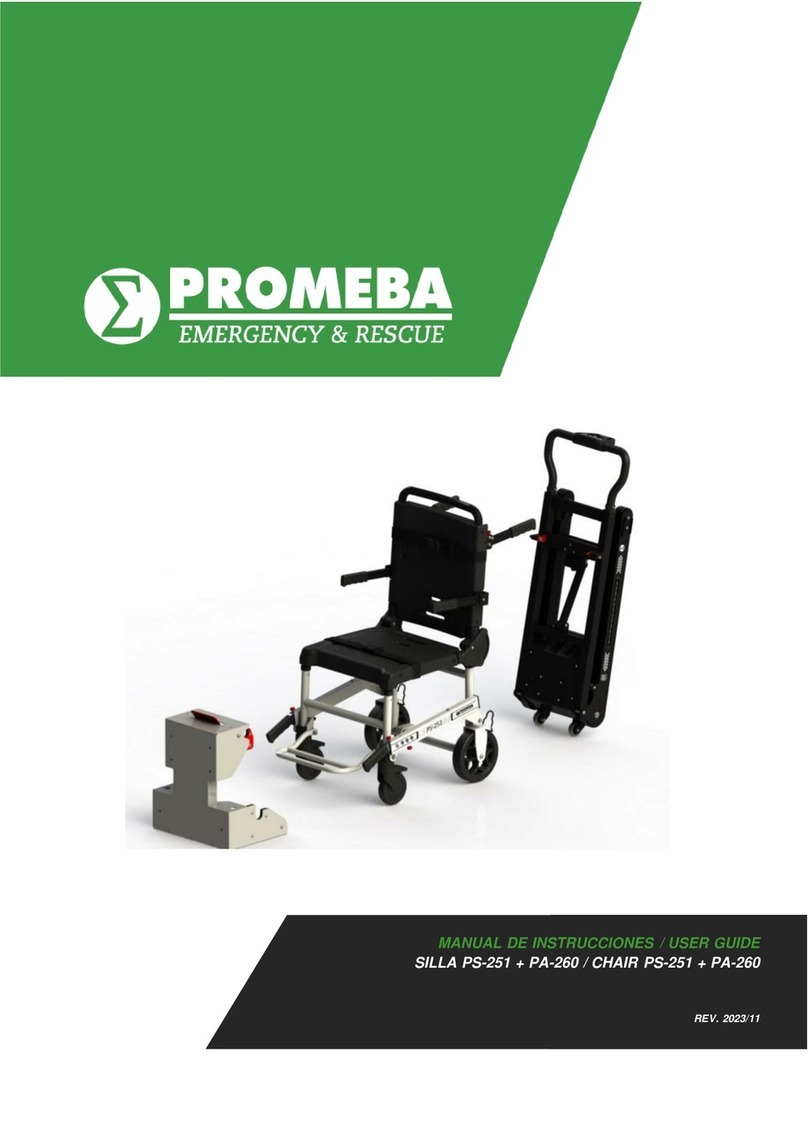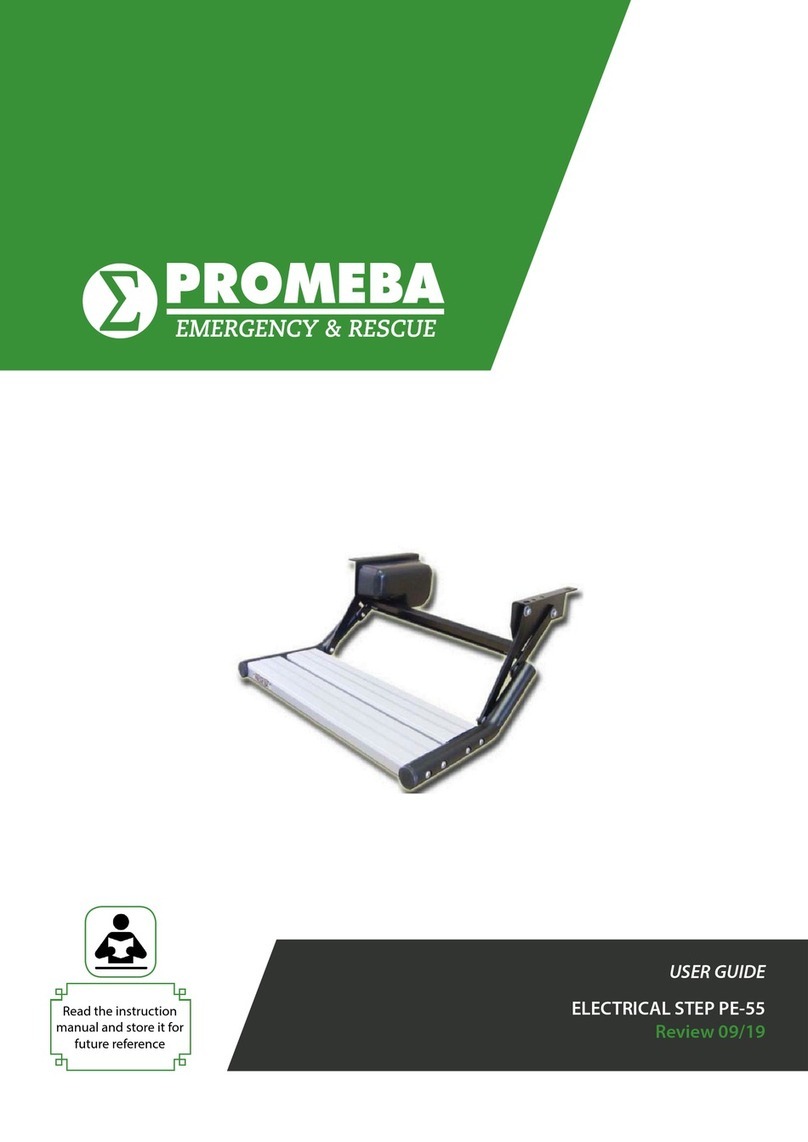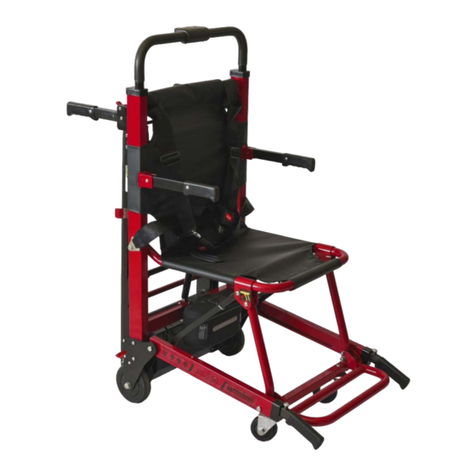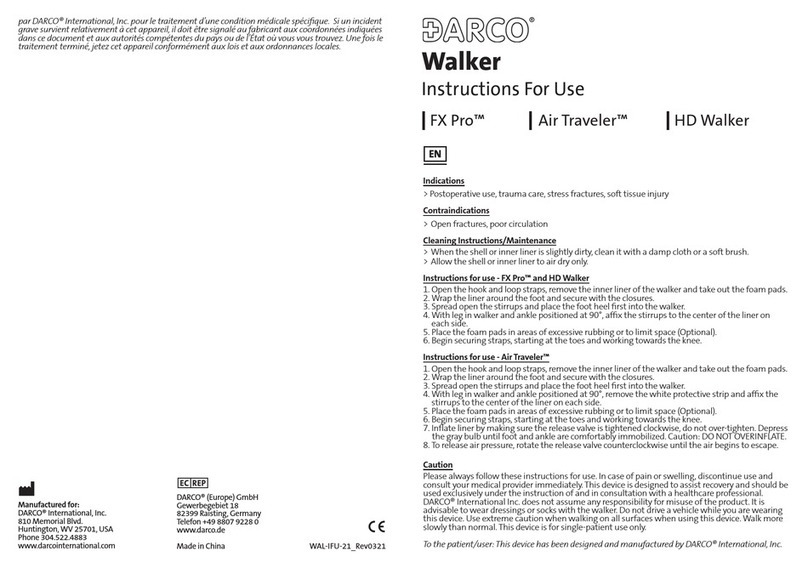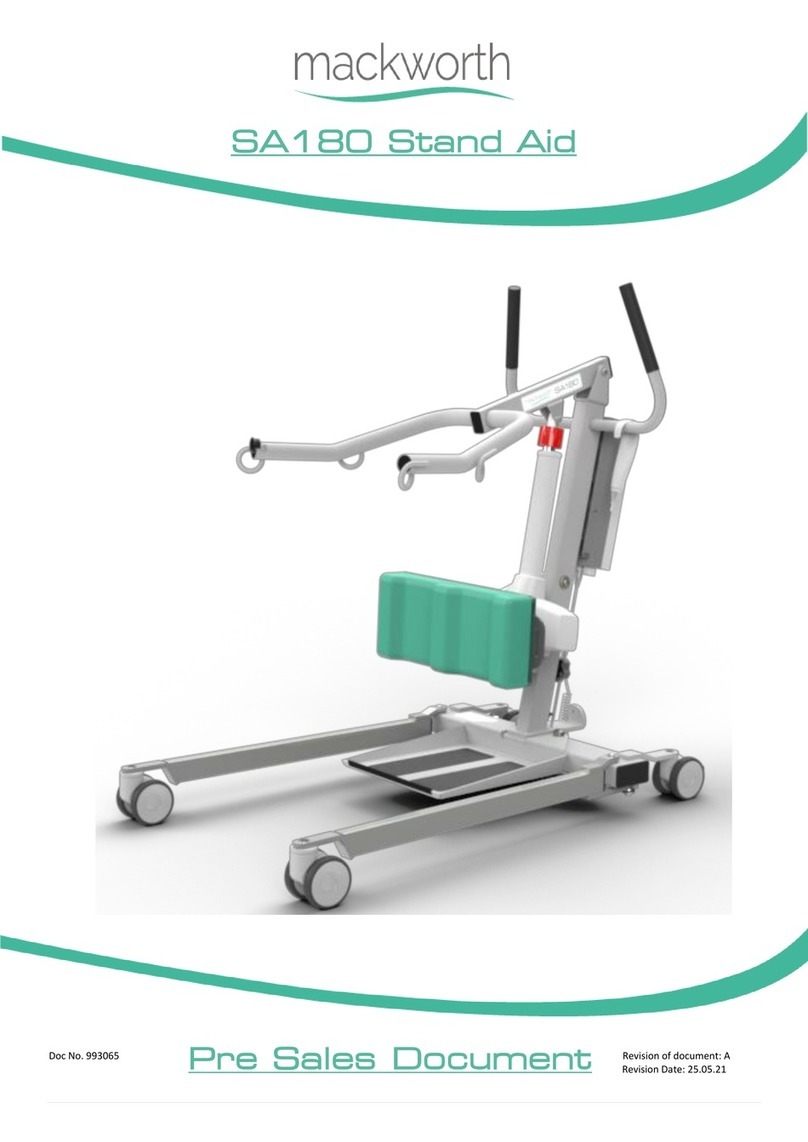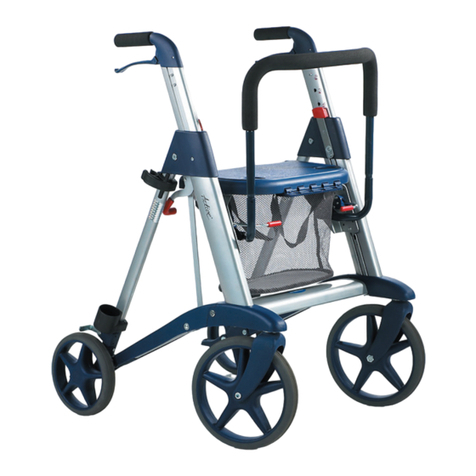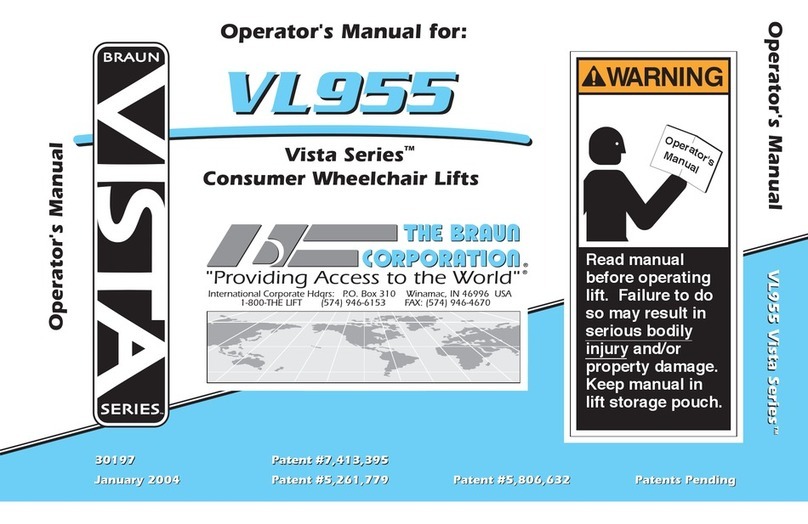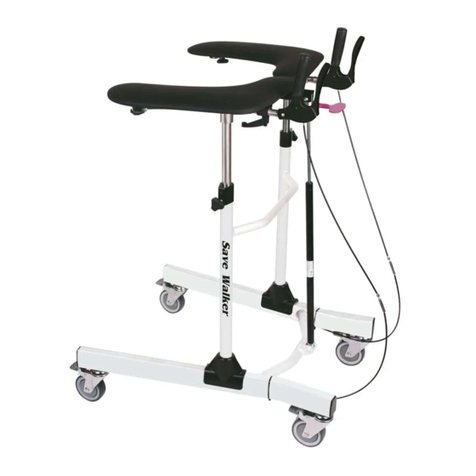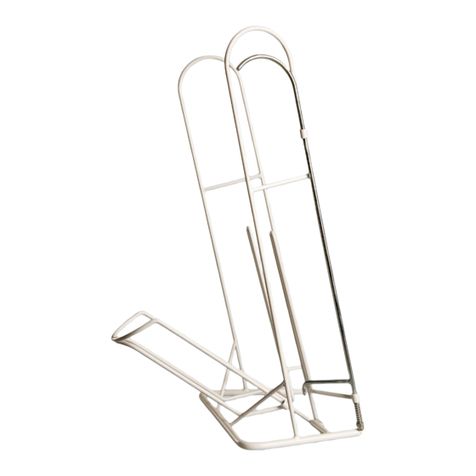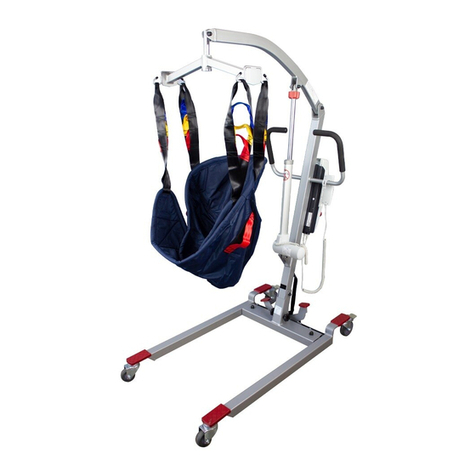Promeba PS-190 User manual

USER GUIDE
ELECTRIC CHAIR PS-190
Review 11/20
Read the instruction
manual and store it for
future reference


USER GUIDE // ELECTRIC CHAIR PS-190
Review 11/20
3
INDEX
01 INTRODUCTION
01.1 Using this manual ·············································································································································· 04
01.2 Meaning of Symbols ········································································································································· 05
01.3 Serving request ··················································································································································· 05
01.4 Demolition ···························································································································································· 05
01.5 Characteristics ····················································································································································· 06
01.6 Technical data sheet ········································································································································· 07
02 WARNINGS
02.1 General warnings ··············································································································································· 08
02.2 Specic warnings ··············································································································································· 10
02.3 Contradictions and side eects ···················································································································· 11
02.4 Physical requirements of the operators ····································································································· 11
03 INSTALLATION
03.1 Transporting and unpacking ························································································································· 12
03.2 Chair’s preparation ············································································································································ 13
04 OPERATING
04.1 General elements of evacuation chair PS-190 ························································································· 14
04.1.1 Armrests ··········································································································································· 15
04.1.2 Footrest ············································································································································ 15
04.1.3 Telescopic handles ······················································································································· 16
04.1.4 Foldable transport handles ······································································································· 16
04.1.5 Telescopic backrest ······················································································································ 17
04.1.6 Belts ··················································································································································· 17
04.1.7 Rear swivel wheels with brake ································································································· 17
04.1.8 Folding system ······························································································································ 18
04.1.9 Track system with anti-slide belts ·························································································· 18
04.1.10 Track operation ····························································································································· 19
04.1.10 Battery installation ······················································································································ 20
04.1.10 Troubleshooting ··························································································································· 21
05 MOUNTING AND COMPONENTS
05.1 General exploded PS-190 ································································································································ 22
05.2 Bill of materials general exploded PS-190 ································································································ 23
06 GENERAL MAINTENANCE ································································································································ 25
07 LEGAL NOTICES ··················································································································································· 26
08 PRODUCT WARRANTY ······································································································································ 27
09 TRAINING REGISTER ·········································································································································· 28
10 MAINTENANCE REGISTER ································································································································ 29

USER GUIDE // ELECTRIC CHAIR PS-190
Review 11/20
4
01.1 Using this manual
This manual provides using and maintenance instruc-
tions of the product, as well as the way of xing minor
faults that could appear.
It is recommended before the operation of the product
to read carefully this manual in order to avoid damages
caused by a misuse.
Do not lose this document, it should be accessible to
any doubt that could appear by medical personnel.
Remember that a good use and maintenance are ne-
cessary for the proper operation of the product.
Each product incorporates an identication sticker with
the serial number and the model. Keep these numbers
so that they can be indicated to the dealer if necessary.
01 INTRODUCTION

USER GUIDE // ELECTRIC CHAIR PS-190
Review 11/20
5
01 INTRODUCTION
01.2 Meaning of Symbols
General warning of
possible injuries Read the user manual
This product is compliant
with the specications of
the Directive 93/42/CEE
ER-0687/1998
Certicate of Quality
Management System IQNet Certicate
QR Code
(Access Online Web) Unlocked Locked
01.3 Serving request
For information of the correct interpretation of the instruction manual, the use, maintenance, installation
and restoration of the product, please contact Promeba customer service T. 93 837 12 00, Fax 93082061008,
email [email protected]om or write to PROMEBA, S.L. - Ctra C-16 Km 59.5 · 08650 Sallent (Barcelona) ·
SPAIN.
01.4 Demolition
When the devices are no longer suitable for use, if they have not been contaminated by any particular
agent, they can be disposed of as normal solid waste, otherwise, follow the current demolition regulations.
WARNINGS FOR THE CORRECT DISPOSAL OF THE PRODUCT IN ACCORDANCE WITH EC DIRECTI-
VE 2012/19/EU WEEE:
At the end of his life, the product must not be disposed as household waste. Can be taken to special
recycling centers provided by local government, or return it to the dealer on purchase of a new
device of the same type and used for the same functions. Dispose of the product separately avoids
possible negative consequences for the environment and human health resulting from inappro-
priate disposal and allows to recover the materials in order to obtain signicant savings in energy
and resources. The symbol on the label indicates separate collection of electrical and electronic
equipment.
Warning: One incorrect disposal of electrical and electronic equipment could result in sanctions.

USER GUIDE // ELECTRIC CHAIR PS-190
Review 11/20
6
01.5 Characteristics
1. The PS-190 chair is specially designed to help in emergency situations with the elderly, public safety,
hospitals, hotels, etc.
2. It can be folded, for easy storage.
3. It can climb up and down stairs smoothly and steadily by track.
4. Thanks to its four wear-resistant rubber wheels, the chair can be used as a wheelchair to travel distances.
5. It has two short handles behind the backrest and two telescopic handles in the lower front part, which
allows a better transport of patients in narrow space.
01 INTRODUCTION

USER GUIDE // ELECTRIC CHAIR PS-190
Review 11/20
7
01 INTRODUCTION
01.6 Technical data sheet
MAX. LOAD 160 Kg
OPERATOR 2
MOTOR 24V-200W o 36V-300W
BATTERY 24V o 36V
MEASURES AND FEATURES OF PACKAGE
QUANTITY 1
SIZE 1160 x 550 x 305 mm
WEIGHT 35 Kg
MEASURES AND FEATURES
LENGTH 800 ~ 1100 mm
WIDTH 500 mm
HEIGHT 1100 ~ 1600 mm
WEIGHT 30 Kg
FOLDED SIZE 1150x500x270 mm

USER GUIDE // ELECTRIC CHAIR PS-190
Review 11/20
8
02 WARNINGS
02.1 General warnings
· The product has to be used by trained personnel only, who must have specic training for the use of this
product and not for similar products.
· Training routines must be registered on a special register in which the names of the persons trained, their
trainers, the place and the date of the training are indicated. This registry, which will certify the eligibility of
the operators to use the Promeba product, must be retained for a period of 10 years after the elimination
of the product. This record will be made available to the competent authorities and/or the manufacturer if
requested.
· Promeba, S.L. is always at your disposal to plan the product formations.
· Before carrying out any type of operation on the product (training, installation, use), the operator must
carefully read the attached instructions, paying special attention to the correct safety precautions and the
procedures that must be followed for the installation and for the correct use.
· If you have any questions regarding the interpretation of these instructions, please contact Promeba, S.L.
for any kind of clarication.
· If the instructions belong to another device and not to the purchased device, inform the manufacturer
immediately and avoid the use of this device.
· Before each use of the device, the perfect functioning of the device must be veried, as specied in the
instruction manual. In case of detecting damages or anomalies that could inuence in some way the correct
functioning or safety of the device, the patient or the operator; the device must be immediately removed
from service and you must contact the manufacturer.
· In case of detecting any failure or incorrect functioning of the device, it must be replaced immediately by a
similar device in order to be able to guarantee the rescue procedures without any interruption.
· Regularly check the product, carry out the prescribed maintenance and respect the service life, as indica-
ted by the manufacturer in this manual.
· Do not allow people without training to help during the use of the device, because they could cause da-
mage to the patient or to themselves.
· It is totally forbidden to use the device in any other way than the one described in this manual.
· Do not alter or modify this device in any way; any modication of this device could cause malfunctions and
injuries to the patient and/or rescue personnel.
· Handle with care.
· The device must not be manipulated in any way (modication, adjustment, replacement). In such cases all
responsibility will be denied for any malfunctions or injuries caused by this device. In addition, CE certica-
tion and product warranty will be considered void.
· All those who modify or have modied, prepared or have prepared medical devices in such way that they
no longer serve the purpose for which they were designed, or no longer provide the desired service, must
satisfy the valid conditions for the introduction of these in the market.
· Register and store with these instructions: lot number, place and date of purchase, rst date of use, date of
checks, name of operators and any other comments.
· Be sure to take all necessary precautions to avoid the dangers that may arise as a result of contact with
blood or body uids.

USER GUIDE // ELECTRIC CHAIR PS-190
Review 11/20
9
· Do not store the device under heavy objects that could cause structural damage.
· Store in a cool, dry, dark place and do not expose the device directly to the sun.
· Store and transport the product in its original packaging.
· The product must not be exposed or come into contact with any source of combustion or ammable
agents.
· Position and adjust the device being careful not to cause any obstruction to rescuers and/or any other
rescue equipment.
· When the product is being used, the assistance of qualied personnel must be guaranteed
· Attention: laboratory tests, post-production tests, instruction manuals cannot always consider all possible
scenarios of use. This means that, in some cases, the performance of the product could have signicantly
dierent from results to date obtained. Instructions are continually updated and are under the strict super-
vision of fully qualied personnel with the appropriate technical formation.
· In addition, both public and private services are obliged to inform the manufacturer of any measures that
should be adopted in order to take the necessary steps to guarantee the safety and health of patients and
users of any medical device.
· As a distributor or end users of products manufactured and/or marketed by Promeba, S.L., it is strictly
required that you have a basic knowledge of any legal requirement that applies to the supplied devices, for
the countries in which they will end up (including laws and norms regarding technical specications and/or
safety requirements) and, therefore, it is also strictly required to have the necessary knowledge to guarantee
all aspects related to the total conformity of the products to the regulations in the corresponding territory.
· Promptly notify Promeba, S.L. with respect to any revision that the manufacturer must carry out in order
to guarantee the conformity of the product to the legal specications of the territory (including those resul-
ting from rules and/or norms of other nature).
· Act, with due care and diligence, and help ensure compliance to general security requirements of all de-
vices marketed in the territory, providing end users with all the information necessary to perform periodic
checks of their devices, as specied in the instruction manual.
· Actively contribute to the security controls of the products sold, communicating any relevant risk analysis
information both the manufacturer and to competent authorities so that the necessary measures can be
taken promptly.
· You are aware that, in case of it does not comply with the above mentioned requirements, you will be
considered totally responsible for all damages that may occur. Therefore we expressly disclaim any respon-
sibility and/or liability for your non-compliance with the present regulatory provisions.
02 WARNINGS

USER GUIDE // ELECTRIC CHAIR PS-190
Review 11/20
10
02.2 Specic warnings
· Establish a maintenance program and periodic tests, identifying a reference employee. The person entrus-
ted with the ordinary maintenance of the device must guarantee the basic requirements foreseen by the
manufacturer in the user manual.
· Use only accessories/spare parts original or approved by Promeba, S.L., in order to carry out any operation
without altering or modifying the device; otherwise we assume no responsibility for the correct operation
or damage resulting from the device to the patient or the operator and the warranty will be considered
void, in accordance with the compliance of the Medical Device Directive 93/42/EEC.
· Always respect the maximum load capacity of the device, as indicated in this manual. The maximum load
capacity means the total weight distributed according to the human anatomy. When determining the load
of the total weight on the product, the operator should consider the patient’s weight, equipment and ac-
cessories. In addition, the operator must consider that the overall dimensions of the patient do not reduce
the functionality of the device.
· Never leave the patient without any assistance in the device, because he could be injured.
· The device and all its components, after being washed, should be allowed to dry completely before stora-
ge.
· Lubrication must be carried out after cleaning and complete drying.
· Follow the procedures approved by the Emergency Medical Services for the immobilization and transpor-
tation of the patient.
· Follow the procedures approved by the Emergency Medical Services for the positioning and transporta-
tion of the patient.
· Avoid contact with sharp objects.
· Do not use the device if it is pierced, torn or frayed.
· Make sure that, before lifting the device, operators have a rm grip on the device.
· Avoid pulling the device on rough surfaces.
· Do not lift by crane or other mechanical lifts.
· The device is a stretcher/chair for transporting patients and cannot be used as a stationing device.
First, practice with an empty stretcher/chair to get used to the way in which the stretcher/chair maneuvers.
· For the use of the device, at least two operators are needed in appropriate physical conditions; therefore,
they must have strength, balance, coordination and common sense and must be trained on the correct
functioning of the device of the stretcher/chair.
· For techniques for loading particularly heavy patients, for rescue operations on steep ground or in unusual
circumstances, the presence of more operators is recommended (not only two, as required under standard
conditions).
· The maximum weight sustained by each rescuer must comply with the requirements prescribed by the law
of the country, related to health and safety at work.
· Before each use, check the integrity of the belts and their hooks, as specied in the manual. In case of
malfunction or any damage that may compromise the function and safety of the device, the patient or the
operator, it is necessary to replace the belts.
02 WARNINGS

USER GUIDE // ELECTRIC CHAIR PS-190
Review 11/20
11
· Make sure the belts are tight to the chassis of a stretcher/chair.
· Always immobilize the patient, using the straps supplied by the manufacturer; the lack of immobilization
can cause serious damage.
· Use the emergency chair only as described in this manual.
· Do not alter or modify the emergency chair arbitrarily to make it t into the ambulance: the modication
can cause unpredictable functioning and damage to the patient and operators. In any case the guarantee
will be lost.
· Pay close attention to possible obstacles (water, ice, debris, etc.) on the route of the stretcher/chair, becau-
se they could cause loss of balance for the operator and compromise the proper functioning of the device.
If you cannot set the path free from obstacles, choose an alternative path.
· For height gradients, the device must be raised, taking care to grasp the structure and not from the banks/
platforms.
· Condensation, water, ice and accumulations of dust can aect the correct functioning of the device, which
makes it unpredictable and causes a sudden change in the weight that operators have to carry.
· The transport chairs are certied for use with Promeba fastening systems, therefore, the use of belts not
approved by the manufacturer is prohibited. Fastening systems that have not been approved can alter the
structural and functional characteristics of the chairs.
· Replace the wheels with original parts, in case of failure to stop the device.
02 WARNINGS
02.3 Contradictions and side eects
The use of this device, if used as described in this manual, does not present any contradiction or collateral
eect.
The operators must be trained to be able to transport eciently, eciently and safely.
For extremely heavy patient loading procedures, operations on dicult terrain and, in parti-
cular situations more operators may be needed (not only 2 as in normal conditions).
The capabilities of the various operators must be considered before determining the func-
tion they will have in the operation of the device.
02.4 Physical requirements of the operators
This product is intended only for use by specialized operators. The rescue team must have, at least, the
following requirements:
·Physical capacity to be able to operate the device.
·Being able to grasp the device rmly with both hands
·Strong back, arms and legs to lift, push and pull the device.
·Have a good muscular coordination.

USER GUIDE // ELECTRIC CHAIR PS-190
Review 11/20
12
03.1 Transport and unpacking
First remove the packaging carefully so as not to dama-
ge the outside of the chair
1. Transport
Before transporting the product, make sure it is pro-
perly packed, making sure there are no risks of crashes,
bumps or falls during transport.
Keep the original packaging for use in case of any other
transport and storage. Damage to the product caused
during transportation and handling is not covered
by the warranty. Repairs or replacement of damaged
parts are the responsibility of the customer. The devi-
ce should be stored in a dry and cool place, away from
direct sunlight. It must not come into contact with che-
mical substances or agents that may cause damage
and reduce safety features.
During storage, do not place heavy materials on the
device. The product must not be considered or used as
a shelf for any type of material.
· Always x the load, if it is necessary stack. You should
follow the diagram shown.
· Transport the level load and following all the precepts
and regulations regarding the transport of loads.
2. Unpacking
· Put the box on a at and stable surface, open the seal
carefully not to damage inside.
· Remove the product from the inside of the case as
shown in the chart below.
Each product has been thoroughly inspected when
leaving the factory.To ensure that the transport has not
deteriorated it, please inspect the exterior and interior
carefully, and in the event of any damage, contact the
installer immediately.
PACKING UNIT
RESPECT THE PACKAGING TRANSPORT POSITION
UNPACKING THE PRODUCT
ALWAYS USE FLAT SURFACE
03 INSTALATION

USER GUIDE // ELECTRIC CHAIR PS-190
Review 11/20
13
03.2 Chair preparation
On receipt of the product it is advised:
· Remove the packaging and distribute the material such that all components are visible.
· Verify that all components / parts in the attached list are present.
The appliance must be checked before each use in order to detect any malfunction and / or damage caused
by transport and / or storage. In particular, check:
· General functionality of the device.
· Cleaning the device (remember that lack of cleanliness can cause the risk of cross-infection).
· Absence of cuts, holes, rips in the structure, including belts.
· Correct xing of all nuts, bolts and nuts.
· Correct xing of the belts.
· Correct attachment of the belts.
· State of use (moving parts, wheels, belts, covers)
· Integrity of belts and covers.
· Integrity of the components.
· Integrity of the handles.
· Lubrication of moving parts.
· State of use of the wheels and braking system.
· Operation of springs.
· The emergency vehicle is equipped with a fastening system dedicated to the Promeba product.
· There are safety belts for the immobilization of the patient and they are intact and operating.
· The welds are intact, without cracks or breaks.
· No tube or sheet metal present curves or cracks
If the above conditions are met, the device can be considered ready for use; otherwise, you must immedia-
tely remove the device from the service and contact the manufacturer.
03 INSTALATION

USER GUIDE // ELECTRIC CHAIR PS-190
Review 11/20
14
2
1
5
11
3
6
10
7
4
04.1 General elements of CHAIR PS-190
1. Armrests
2. Belts
3. Telescopic handles
4. Footrest
5. Telescopic backrest
6. Foldable transport handles
7. Rear wheels with brake
8. Front swivel wheels
9. Control panel
10. Folding system with safe anti-fold
11. Track system with anti-slide
9
04 OPERATING
8

USER GUIDE // ELECTRIC CHAIR PS-190
Review 11/20
15
04 OPERATING
04.1.1 Armrests
The armrest has two positions:
1Lowered for use (Figure 1)
2 Lifted (Figure 2)
- To lower the armrest, push it down until it stops.
- To lift the armrest, lift it until it stops.
Instructions for using the armrest:
·Keep the armrest raised when it is not in use.
·Keep the armrest clean, avoiding patient contact with
external uids. FIGURE 1 - LOWERED ARMREST FIGURE 2 - LIFTED ARMREST
04.1.2 Footrest
The footrest has two positions:
1Lowered for use (Figure 3)
2Lifted (Figure 4)
- To lower the footrest, lower it down until it stops.
- To lift the footrest, lift it until it stops.
Instructions for footrest use:
· Use the footrest correctly. Make sure that it does not
interfere with the patient’s or operator’s feet.
· Before transferring the patient to the chair, make sure
that the footrest is raised. Sit down the patient before
lowering the footrest.
· When moving the patient from the chair, lift the foo-
trest before unfastening the belts. This will prevent the
patient from trying to stand up before folding the foo-
trest.
· Keep the footrest elevated when it is not in use.
FIGURE 3 - LOWER FOOTREST
FIGURE 4 - LIFTED FOOTREST

USER GUIDE // ELECTRIC CHAIR PS-190
Review 11/20
16
Instructions for use of transport handles:
·Keep the carrying handles down when not in use.
·Keep the carrying handles clean, avoiding operator contact with external uids.
04 OPERATING
04.1.3 Telescopic handles
The telescopic handles adjust to two locked positions. Adjust the handles according to the preferences of
the operator and the task.
FIGURE 5 - TELESCOPIC HANDLE
04.1.4 Foldable transport handles
The transport handles have two positions:
1Lifted for use
2 Folded
- To lower the carrying handles, press the release but-
ton (Figure 6) and push them down until they stop.
- To raise the carrying handles, lift them until they stop.
EXTEND THE HANDLES:
1Press the release button (Figure 5) and pull the handle
2Release the button and slide the handle forward until
it clicks into place.
3Lock both handles in the same position. Verify that
both handles are locked by pushing or pulling them,
without pressing the release buttons.
RETRACT THE HANDLES:
1 Press the release button (Figure 6) and push the handle.
2Release the button and slide the handle backwards until it clicks into place.
3Lock both handles in the same position. Verify that both handles are locked by pushing or pulling them,
without pressing the release buttons.
FIGURE 6 - FOLDABLE TRANSPORT HANDLES

USER GUIDE // ELECTRIC CHAIR PS-190
Review 11/20
17
04.1.5 Telescopic backrest
The telescopic backrest positions are:
1 Folded for transport on land
2Unfolded for stair transport.
It has three unfolding heights to be able to adjust it ac-
cording to the height of the operator and the inclina-
tion of the stairs (Figure 7)
To unlock the backrest movement, pull the black bar up
while pulling or lowering the backrest, depending on
the position you want to adopt (Figure 8).
04 OPERATING
FIGURE 7 -
TELESCOPIC BACKREST POSITIONS
FIGURE 8 -
UNLOCK TELESCOPIC BACKREST
04.1.7 Rear swivel wheels with brake
The rear wheels of the chair are equipped with brakes
to prevent the chair from moving during the transfer of
the patient or during a stop.
- To activate a wheel lock, press down on the rear lock
pedal (Figure 11)
- To deactivate a wheel lock, press down on the front
release pedal (Figure 11)
FIGURE 11 - REAR WHEELS WITH BRAKES
Keep control of the chair at all times.
Do not use wheel locks as a substitute for operator control.
FIGURE 9 - CLOSURE BELTS FIGURE 10 - BELT POSITION
04.1.6 Belts
Use belts systems to support the patient in the chair.
Follow these instructions to properly anchor the belts:
1Attach the buckles as indicated in Figure 9, until the
system closes and you see that it does not open.
Instructions for use of the belts:
· Make sure that they are well secured in their respecti-
ve anchor points, which can be seen in Figure 10.
· Use a minimum of two belts.

USER GUIDE // ELECTRIC CHAIR PS-190
Review 11/20
18
04 OPERATING
04.1.9 Track system with anti-slide belts
OPENING OF THE TRACK SYSTEM
1Open the side lock and pull the black tube (Figure 14)
2Verify that the system has been locked by pushing it
as if you wanted to close it. If the blockage is complete-
ly engaged, the track system will not close.
CLOSURE OF THE TRACK SYSTEM
1Push down the red tube along the slot to fold the
track (Figure 15). Track will be locked automatically by
side lock.
2Verify that the system has been locked by pushing it
as if you wanted to open it. If the blockage is complete-
ly engaged, the track system will not open.
ADJUST TRACK TIGHTNESS
Check periodically the tension of the track belts.
IF it is too loose or tight, adjust it with a socket head
wrench as shown in gure 16.
04.1.8 Folding system
To fold the chair follow the instructions below:
1Locate the black release bar under the seat.
2Pull the bar along the slot until the chair is folded
To unfold the chair, follow the instructions below:
1Follow the process described above in reverse.
2Make sure that the chair is securely locked and that
the anti-fold lock works properly.
Make sure the bar is securely locked before using the chair.
FIGURE 12 - CHAIR FOLDING OPERATION
FIGURE 13 - ANTI-FOLD LOCK
FIGURE 14 - OPENING TRACK SYSTEM FIGURE 15 - CLOSING TRACK SYSTEM
Do not overly tight the screw above the track. It can
cause some noise on the bearing of the gear, and it can
even lead to a fail of the chair control system.
FIGURE 16 - ADJUST BELT TIGHTNESS

USER GUIDE // ELECTRIC CHAIR PS-190
Review 11/20
19
04 OPERATING
04.1.10 Track operation
Warnings:
·The use of the chair on the stairs requires a minimum of two trained operators. It is recommended to use
a third person as an“observer”.
·Verify that the tracking system is completely open and locked before using it.
·Never lubricate the belts. Lubrication can cause the belts to work unpredictably, which can cause injury to
the patient and/or operators.
·Moisture, water, snow, ice or debris on or between track and belts can cause uneven belt operation that
causes sudden changes in the weight that operators must bear. Make sure the tracks and belts are clean and
dry before using the chair on the stairs.
·Humidity, water, snow, ice or debris on ladders can cause poor balance for operators. To avoid possible
injuries, clear the stairs or select an alternative route.
·This product is suitable for any type of stair
GO DOWN THE STAIRS
1Open battery switch.
2Push the chair to the top of the stairs, and tilt it back.
3 Press and hold he “down”button. The track will go upstairs by itself. You will need to hold it and keep it in
a straight line.
GO UP THE STAIRS
1Place the chair with its back to the stairs and tilt it.
2Press and hold the“up”button. The track will go upstairs by itself. You will need to hold it, keep it in a strai-
ght line, and press lightly on the backrest to ensure a steady climbing.
STOP ON THE STAIRS
1 Conrm that the track surface is in contact with at least three steps, then release the raise or lower button.
The chair will remain stable in this position.
ADJUST THE SPEED
1Press the “up”button and the + or - buttons to adjust the upstairs speed.
2Press the “down”button and the + or - buttons to adjust the downstairs speed.
CONTROL PANEL
1Up
2Down
3 LED light
4Increase speed
5Reduce speed
6Power button
FIGURE 17 CONTROL PANEL FUNCTIONS
2 5 4 3 6 1

USER GUIDE // ELECTRIC CHAIR PS-190
Review 11/20
20
04.1.11 Battery installation
· Insert the battery to the slot. It can be locked by key
(Figure 18)
· The battery charging time is 5-6 hours.
· When the battery is charging, the charger light is red.
· When it is fully charged, the light turns green. It is re-
commended to continue charging for one more hour
once the green light has turned on.
· Battery can last 1.5 hours once fully charged, which
is equal to climbing and down 30 times a 5-story buil-
ding.
· When the chair is not in use, close the battery switch.
· If the chair is not used for a long time, the battery
should be charged every 3 months.
· The battery can be charged 500 times
· The useful life of the battery is 3-5 years.
FIGURE 18 - BATTERY
04 OPERATING
Other manuals for PS-190
2
Table of contents
Other Promeba Mobility Aid manuals
Popular Mobility Aid manuals by other brands
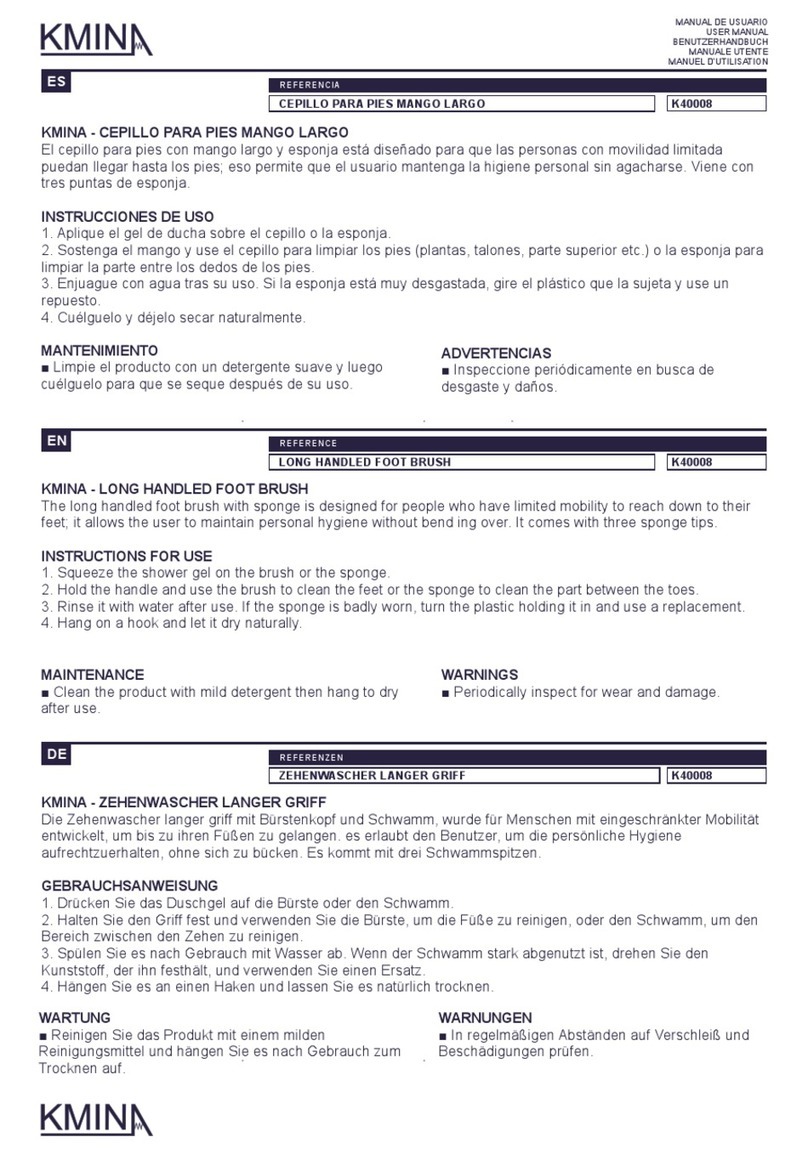
KMINA
KMINA K40008 user manual

Drive DeVilbiss Healthcare
Drive DeVilbiss Healthcare 10495-30 Instructions for use
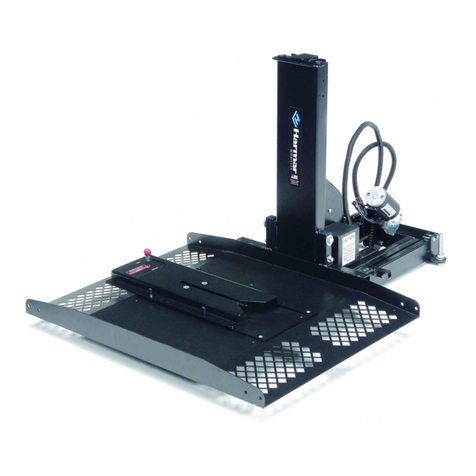
Harmar Mobility
Harmar Mobility AL650 Installation and owner's manual
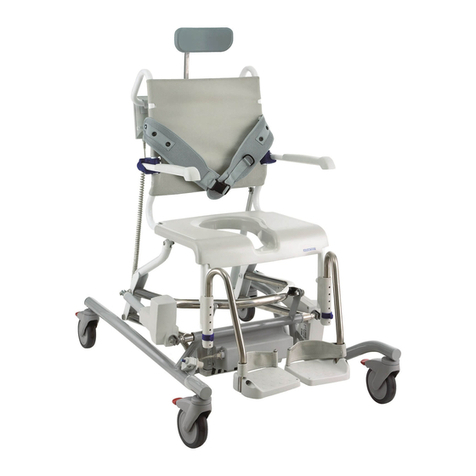
Invacare
Invacare Aquatec Ocean E-VIP user manual

Drive
Drive Posterior Safety Roller quick start guide

Direct Supply
Direct Supply Direct Choice Assembly instructions
